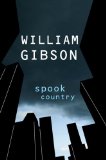Spook country by William Gibson. Gibson has always been one of my favourite authors, mostly due to the way he incorporate technology into his novels. I cannot recall where I read it but someone once said that for immediate news read the papers but for future change, read contemporary novels. They are picking up the undercurrent of change before it hits the main stream media. I always liked that thought. The main stream media has no longer got the luxury of time. Look at CNN for instance. They only report what they see. If an incident take place it takes a long time before you will get deeper facts but already by then they have had hundred plus of updates to their news bulletin. I rather watch national geographic than CNN. Contemporary novels over main stream media. Last, but not least, industry blogs and social networks.
With William Gibsons novels readers are expecting the latest in technology applied in an realistic manner. I read an interview with William Gibson where he said readers suggested the interaction between the book and the Internet. Hyperlinks embedded. To that he replied that he’s already doing that. Try googling some of the references and you get to another level of the book. Let your neurons fire, a thought leads to another and more. Before you know it, you have taken a mental road trip, discovering tidbits you didn’t know before. It’s a ride well worth taking similar to the long forgotten Sunday stroll. Discoveries can be a good thing. Wired did so here in this interview.
However, the current obsession about new technology advances and the rumours of new gadgets before they are launched can take it’s toll and distract focus no matter how much anti shake you put on.
Before the digital revolution, you bought a camera body and stocked up with prime lenses. Glass has always been an investment. The camera body would almost last a lifetime. If the shutter played up, you replaced it and it was good as new. The capture media was the film itself, and you always had access to the latest in film technology.
With digital, your camera body starts to become obsolete the moment you buy it. Every new camera upgrade creates something better, but unlike buying a new roll of film, you have to buy a whole new camera. Suddenly having access to the latest technology became very expensive. In that context, suggestions of camera systems with upgradable sensors make sense from a consumer point of view. For medium format systems you can upgrade the back, but then you also get tempted to upgrade the body too when they have a new and improved model available.
Unless you have unlimited funds available, there is a point where you use what you got in the best way you can. Want that panorama image, try stitching. Only got one flash, start bouncing light with reflectors and mirrors. Don’t let the equipment you want to have put you off shooting in the first place.
Do we need the 60 million pixels? Someone said that with so many pixels you have a lot of lee way when you crop the image. To me it sounds a bit sloppy. I’m old fashioned in that sense that I prefer to crop in camera than after. Why? One example, when I was working as an art director and the editor brought me the images from a beauty session I could only see the full face shots and not the detail shots of the eye and lips. I asked for the missing images only to be told that we could crop from the full headshot. Yes, we can do a crop but it’s a lazy option and not a creative one. You will not get the same quality and feel from a crop that you get with a close up macro shot. With the macro shot you get to play with depth of field and you can create different angles. Why would I use the same image three times when I can have three different and more compelling images. Of course I ordered a re-shoot of the session and made sure that every consequent session had individual shots and not just one headshot.
Quality always matter.
